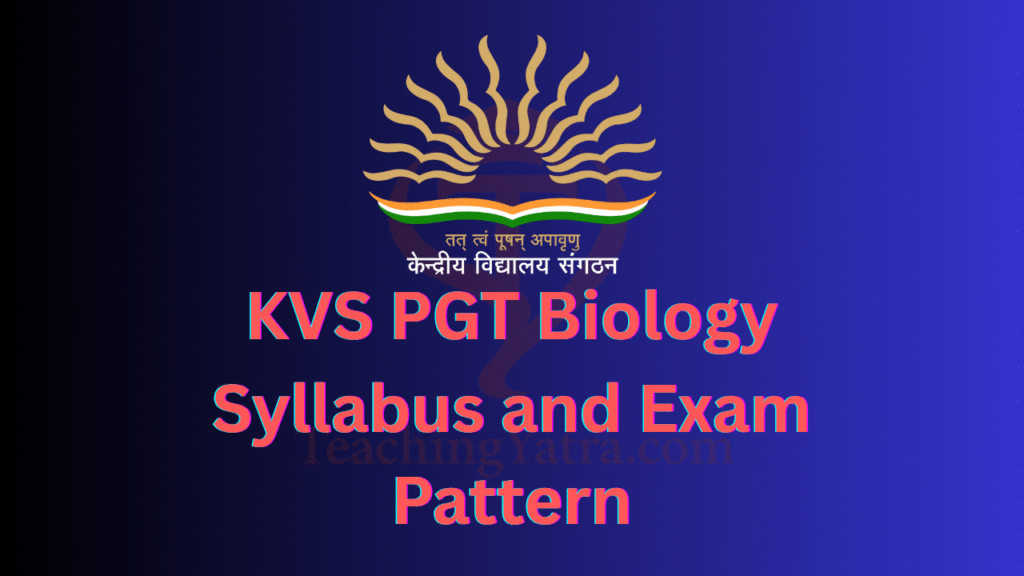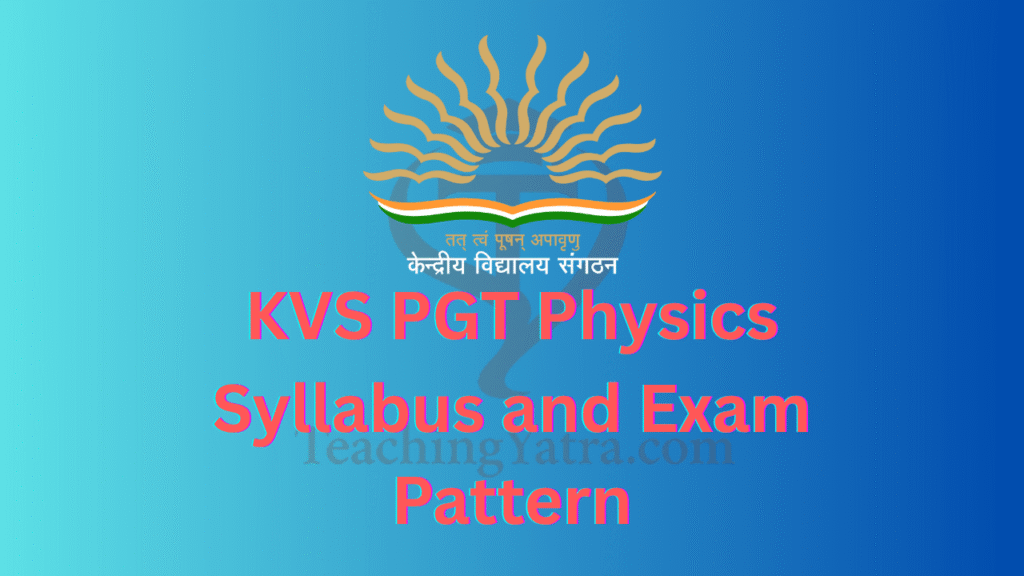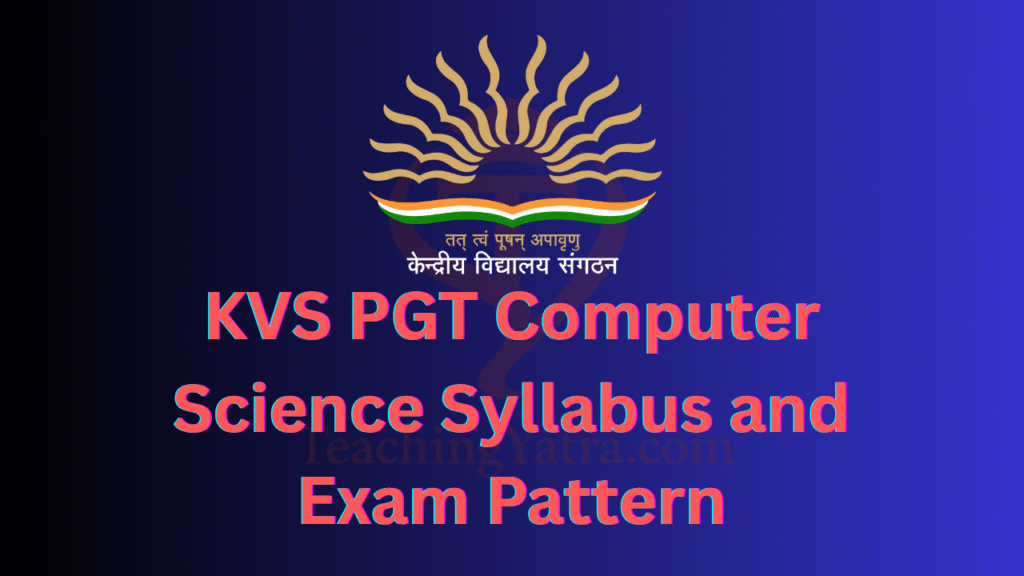
The official KVS PGT Biology Syllabus 2025 is now available on the Kendriya Vidyalaya Sangathan (KVS) website. This detailed syllabus is crafted to evaluate a candidate’s subject knowledge in Biology, as well as their language skills, teaching aptitude, and overall suitability for the Post Graduate Teacher (PGT) role. It emphasizes the essential competencies required to teach Biology effectively at the senior secondary level in Kendriya Vidyalayas. A clear understanding of the syllabus will enable candidates to prepare efficiently, concentrate on important topics, and enhance their chances of success in the exam
Table of Contents
KVS PGT Biology Syllabus 2025: Overview
The syllabus provides a clear roadmap for aspirants preparing for the KVS Recruitment Exam 2025 for the post of PGT Biology. Conducted by Kendriya Vidyalaya Sangathan (KVS), the selection process includes a national-level online written test followed by an interview. The exam aims to assess both the candidate’s grasp of Biology and their teaching aptitude. Staying updated with the official syllabus and planning a focused study strategy will greatly improve the chances of success.
The Biology Syllabus covers a wide range of advanced topics aligned with the senior secondary NCERT curriculum, including Diversity of Living Organisms, Cell Structure and Function, Plant and Human Physiology, Genetics and Evolution, Reproduction, Biotechnology, Ecology, and Biology in Human Welfare. This comprehensive syllabus ensures that candidates are well-equipped with deep subject knowledge and essential teaching skills needed to become successful Post Graduate Biology Teachers in Kendriya Vidyalayas.
KVS PGT Biology Exam Pattern 2025
The KVS PGT Biology Exam consists of 180 objective-type multiple-choice questions carrying 1 mark each, making a total of 180 marks. The exam is conducted in English and Hindi (bilingual format), and candidates are given 3 hours (180 minutes) to complete it.
KVS PGT Biology Marks Distribution
The exam is structured into four major parts with marks distributed as follows:
| Part | Subject Area | No. of Questions | Marks |
|---|---|---|---|
| Part I | General English | 10 | 10 |
| General Hindi | 10 | 10 | |
| Part II | General Awareness & Current Affairs | 10 | 10 |
| Reasoning Ability | 5 | 5 | |
| Computer Literacy | 5 | 5 | |
| Part III | Perspectives on Education and Leadership | 40 | 40 |
| Part IV | Biology (Subject Concerned) | 100 | 100 |
| Total | 180 | 180 |
Detailed KVS PGT Biology Syllabus 2025
Subject specific syllabus includes the concepts of NCERT/CBSE syllabus and Text Books (Classes XI & XII), however, the questions will be testing the depth of understanding and application of these concepts at the level of Post- Graduation.
The Living World
Biodiversity; Need for classification; three domains of life; taxonomy and systematics; concept of species and taxonomical hierarchy; binomial nomenclature
Biological Classification
Five kingdom classification; Salient features and classification of Monera, Protista and Fungi into major groups; Lichens, Viruses and Viroids
Plant Kingdom
Classification of plants into major groups; Salient and distinguishing features and a few examples of Algae, Bryophyta, Pteridophyta, Gymnospermae (Topics excluded – Angiosperms, Plant Life Cycle and Alternation of Generations)
Animal Kingdom
Salient features and classification of animals, non-chordates up to phyla level and chordates up to class level (salient features and a few examples of each category)
Morphology of Flowering Plants
Morphology of different parts of flowering plants: root, stem, leaf, inflorescence, flower, fruit and seed. Description of families: Solanaceae
Anatomy of Flowering Plants
Anatomy and functions of tissue systems in dicots and monocots
Structural Organisation in Animals
Morphology, anatomy and functions of different systems (digestive, circulatory, respiratory, nervous and reproductive) of frog
Cell – The Unit of Life
Cell theory and cell as the basic unit of life; structure of prokaryotic and eukaryotic cells; Plant cell and animal cell; cell envelope, membrane, wall; organelles – structure and function; endoplasmic reticulum, ribosomes, Golgi bodies, lysosomes, vacuoles; mitochondria, plastids, microbodies, cytoskeleton, cilia, flagella, centrioles; nucleus
Biomolecules
Chemical constituents of living cells: biomolecules; structure and function of proteins, carbohydrates, lipids, nucleic acids; Enzymes – properties and action
Cell Cycle and Cell Division
Cell cycle; mitosis and meiosis and their significance
Photosynthesis in Higher Plants
Autotrophic nutrition; site of photosynthesis; pigments; photochemical and biosynthetic phases; cyclic and non-cyclic photophosphorylation; chemiosmotic hypothesis; photorespiration; C3 and C4 pathways; factors affecting photosynthesis
Respiration in Plants
Exchange of gases; glycolysis; fermentation; TCA cycle; electron transport system; ATP generation; amphibolic pathways; respiratory quotient
Plant Growth and Development
Seed germination; growth phases and rate; conditions for growth; differentiation, dedifferentiation, redifferentiation; plant growth regulators: auxin, gibberellin, cytokinin, ethylene, ABA
Breathing and Exchange of Gases
Respiratory organs in animals; human respiratory system; breathing mechanism and regulation; gas exchange and transport; respiratory volumes; disorders – asthma, emphysema, occupational diseases
Body Fluids and Circulation
Blood composition and groups; lymph; human heart and blood vessels; cardiac cycle and output; ECG; double circulation; regulation; disorders – hypertension, coronary disease, angina, heart failure
Excretory Products and their Elimination
Excretion modes – ammonotelism, ureotelism, uricotelism; human excretory system; urine formation; osmoregulation; kidney function regulation; disorders – uremia, failure, calculi, nephritis; dialysis; kidney transplant
Locomotion and Movement
Types: amoeboid, ciliary, flagellar, muscular; skeletal muscles and contraction; skeletal system and joints; disorders – myasthenia gravis, tetany, dystrophy, arthritis, osteoporosis, gout
Neural Control and Coordination
Neuron and nerves; human nervous system; nerve impulse generation and conduction; visceral nervous system
Chemical Coordination and Integration
Endocrine glands and hormones; human endocrine system: hypothalamus, pituitary, pineal, thyroid, parathyroid, thymus, adrenal, pancreas, gonads; hormones of heart, kidney, GI tract; hormone action and disorders – dwarfism, acromegaly, cretinism, goiter, diabetes, Addison’s disease
Sexual Reproduction in Flowering Plants
Flower structure; gametophyte development; pollination types and agents; outbreeding devices; fertilization and post-fertilization events; apomixis, parthenocarpy, polyembryony; seed dispersal and fruit formation
Human Reproduction
Male and female reproductive systems; testis and ovary anatomy; gametogenesis; menstrual cycle; fertilization to blastocyst; implantation; pregnancy, placenta, parturition, lactation
Reproductive Health
Need for reproductive health; STD prevention; birth control methods; MTP; amniocentesis; infertility and ART – IVF, ZIFT, GIFT
Principles of Inheritance and Variation
Mendelian inheritance; deviations – incomplete dominance, co-dominance, multiple alleles; polygenic inheritance; chromosomes, genes; linkage and crossing over; sex determination and inheritance; disorders – thalassemia, Down’s, Turner’s, Klinefelter’s
Molecular Basis of Inheritance
DNA and RNA structure; packaging; DNA as genetic material; replication, transcription, genetic code, translation; gene regulation – lac operon; Human Genome Project; DNA fingerprinting
Evolution
Origin of life; evidences – fossils, anatomy, embryology, molecular; adaptive radiation; Darwin’s theory; evolution mechanisms – variation, natural selection, gene flow, drift; Hardy-Weinberg principle; human evolution
Human Health and Disease
Pathogens and parasites causing diseases (malaria, dengue, typhoid, etc.); immunology basics; vaccines; cancer, HIV/AIDS; adolescence issues – drug and alcohol abuse
Biotechnology – Principles and Processes
Genetic engineering and recombinant DNA technology
Biotechnology and Its Applications
Biotechnology in health and agriculture; GMOs – Bt crops, insulin, gene therapy, diagnosis, transgenic animals; biosafety, biopiracy, patents
Organisms and Populations
Population interactions – mutualism, competition, predation, parasitism, commensalism; attributes – growth, birth/death rate, age distribution
Ecosystem
Ecosystem concepts; productivity, decomposition; energy flow; ecological pyramids
Biodiversity and Conservation
Biodiversity – concepts, levels, patterns, importance, loss; conservation methods; hotspots, endangered species, extinction; Red Data Book, Sacred Groves, reserves, parks, sanctuaries, Ramsar sites
Detailed KVS PGT Biology Syllabus 2025 in Hindi
जीव जगत
जैव विविधता; वर्गीकरण की आवश्यकता; जीवन के तीन क्षेत्र; टैक्सोनॉमी और सिस्टमैटिक्स; प्रजाति और वर्गीकरण पदानुक्रम की अवधारणा; द्विनाम पद्धति
जैविक वर्गीकरण
पाँच जगत का वर्गीकरण; मोनेरा, प्रोटिस्टा और कवक के मुख्य लक्षण और वर्गीकरण; लाइकेन, वायरस और वायरोइड्स
पादप जगत
पादपों का प्रमुख समूहों में वर्गीकरण; शैवाल, ब्रायोफाइटा, प्टेरिडोफाइटा, जिम्नोस्पर्मा के लक्षण और उदाहरण (एंजियोस्पर्म, जीवन चक्र और पीढ़ी परिवर्तन शामिल नहीं)
जन्तु जगत
जन्तुओं के लक्षण और वर्गीकरण; नॉन-कॉर्डेट को संघ स्तर तक और कॉर्डेट को वर्ग स्तर तक (प्रमुख लक्षणों और उदाहरणों सहित)
पुष्पी पादपों की रूपरेखा
फूल वाले पौधों के विभिन्न भागों की संरचना: जड़, तना, पत्ती, पुष्पक्रम, फूल, फल और बीज; सोलानेसी कुल का वर्णन
पुष्पी पादपों की शरीर रचना
डाइकोट और मोनोकोट में ऊतक तंत्र की संरचना और कार्य
जन्तुओं में संरचनात्मक संगठन
मेंढ़क के पाचन, परिसंचरण, श्वसन, तंत्रिका और प्रजनन तंत्र की संरचना और कार्य
कोशिका – जीवन की इकाई
कोशिका सिद्धांत; प्रोकैरियोटिक और यूकैरियोटिक कोशिकाओं की संरचना; पादप और जन्तु कोशिका; झिल्ली, कोशिका भित्ति; कोशिका अंगक – संरचना और कार्य
जैव अणु
जीवित कोशिकाओं के रासायनिक घटक; प्रोटीन, कार्बोहाइड्रेट, वसा, न्यूक्लिक अम्ल की संरचना और कार्य; एन्जाइम की विशेषताएँ और क्रिया
कोशिका चक्र और विभाजन
कोशिका चक्र; मिटोसिस, मियोसिस और उनका महत्व
उच्च पादपों में प्रकाश संश्लेषण
ऑटोट्रॉफिक पोषण; प्रकाश संश्लेषण की प्रक्रिया; वर्णक, चरण, चक्रीय और गैर-चक्रीय फोटॉफॉस्फोराइलेशन; C3, C4 मार्ग; कारक
पादपों में श्वसन
गैसों का आदान-प्रदान; ग्लाइकोलिसिस, किण्वन, TCA चक्र, इलेक्ट्रॉन ट्रांसपोर्ट; ATP का निर्माण; श्वसन कोशांक
पादप वृद्धि और विकास
बीज अंकुरण; वृद्धि के चरण और दर; वृद्धि नियंत्रक: ऑक्सिन, जिबरेलिन, साइटोकाइनिन, एथिलीन, ABA
श्वसन और गैसों का विनिमय
प्राणियों के श्वसन अंग; मानव में श्वसन तंत्र; गैसों का परिवहन और विनियमन; रोग – अस्थमा, एम्फीसेमा आदि
द्रव और परिसंचरण
रक्त संरचना, रक्त समूह, लसीका; हृदय की संरचना और कार्य; ECG; दोहरी परिसंचरण; रोग – उच्च रक्तचाप, हृदय विफलता
उत्सर्जी पदार्थ और उनका निष्कासन
उत्सर्जन के प्रकार; मानव उत्सर्जन तंत्र; मूत्र निर्माण; ऑस्मोरेगुलेशन; गुर्दा कार्य विनियमन; रोग – यूरिमिया, गुर्दा विफलता, डायलिसिस, प्रत्यारोपण
गमन और गति
गमन के प्रकार – अमीबायड, सिलीरी, फ्लेजेलरी, मांसपेशीय; कंकाल तंत्र, संधियाँ; रोग – आर्थराइटिस, ऑस्टियोपोरोसिस, गाउट
तंत्रिका नियंत्रण और समन्वय
न्यूरॉन, तंत्रिकाएँ; मानव तंत्रिका तंत्र; तंत्रिका आवेग का निर्माण और संचरण
रासायनिक समन्वय और एकीकरण
अंतःस्रावी ग्रंथियाँ और हार्मोन; मानव हार्मोन तंत्र; कार्य और रोग – बौनापन, एक्रोमेगेली, घेंघा, मधुमेह, एडिसन रोग
पुष्पी पादपों में लैंगिक प्रजनन
फूल की संरचना; नर-मादा युग्मकोणियों का विकास; परागण; निषेचन; भ्रूण और बीज का विकास; अपोमिक्सिस, पाथेनोकार्पी, बहुभ्रूणता
मानव प्रजनन
पुरुष-महिला प्रजनन तंत्र; शुक्रजनन और अंडजनन; मासिक धर्म चक्र; निषेचन से भ्रूण निर्माण; गर्भावस्था, प्लेसेंटा, प्रसव, दुग्ध स्राव
प्रजनन स्वास्थ्य
STD से बचाव; जनन नियंत्रण विधियाँ; MTP; टेस्टिंग; बांझपन और सहायक प्रजनन तकनीक – IVF, ZIFT, GIFT
वंशागति और विविधता के सिद्धांत
मॉन्डेल के सिद्धांत; अपवृत्तियाँ – अपूर्ण प्रभुत्व, सहप्रभुत्व, रक्त समूह, बहु-जीन वंशागति; क्रोमोजोम सिद्धांत; सेक्स निर्धारण; आनुवंशिक रोग – थैलेसीमिया, डाउन सिंड्रोम आदि
वंशागति का आणविक आधार
DNA, RNA की संरचना; पैकेजिंग; प्रतिकृति, ट्रांसक्रिप्शन, ट्रांसलेशन, जीन अभिव्यक्ति, ह्यूमन जीनोम प्रोजेक्ट, DNA फिंगरप्रिंटिंग
विकास
जीवन की उत्पत्ति; विकास के प्रमाण – जीवाश्म, शरीर रचना, भ्रूण विज्ञान; डार्विन सिद्धांत; प्राकृतिक वरण, अनुवांशिक बहाव, ह्यूमन इवोल्यूशन
मानव स्वास्थ्य और रोग
रोगजनक; मलेरिया, टायफाइड आदि के कारक; टीकाकरण; कैंसर, एड्स; किशोर अवस्था समस्याएँ – नशा
जैव प्रौद्योगिकी – सिद्धांत और प्रक्रिया
अनुवांशिक अभियांत्रिकी (रिकॉम्बिनेंट DNA टेक्नोलॉजी)
जैव प्रौद्योगिकी और इसके अनुप्रयोग
स्वास्थ्य और कृषि में जैव प्रौद्योगिकी; Bt फसलें, इंसुलिन, जीन थेरेपी, ट्रांसजेनिक जन्तु; जैव सुरक्षा, बायोपायरेसी
जीव और जनसंख्या
जनसंख्या परस्पर क्रिया – परस्परवाद, प्रतिस्पर्धा, परजीविता; जनसंख्या लक्षण – वृद्धि, जन्म/मृत्यु दर
पारिस्थितिकी तंत्र
उत्पादकता, अपघटन, ऊर्जा प्रवाह; पिरामिड (संख्या, बायोमास, ऊर्जा)
जैव विविधता और संरक्षण
जैव विविधता – परिभाषा, स्तर, महत्व, हानि; संरक्षण उपाय – हॉटस्पॉट्स, संकटग्रस्त प्रजातियाँ, रेड डाटा बुक, संरक्षित क्षेत्र
Detailed KVS PGT Biology Syllabus 2025 PDF
| KVS PGT Biology Syllabus 2025 | |
| KVS PGT Syllabus 2025 (General Paper) | Click Here |
| KVS PGT Biology Syllabus 2025 | Click Here |

